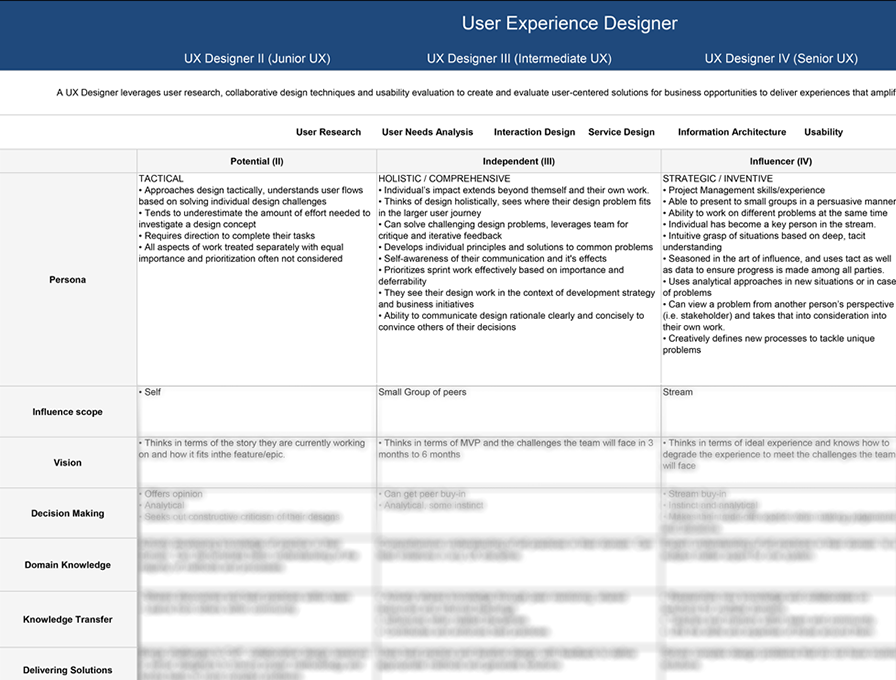UX Excellence through Standards Definition
Introduction
Challenge
Evaluate the ability and performance of the UX Designer / Researchers
eCommerce had just hired a new Director of Experience Design and Practice Leads for each discipline within design: UX, UI, Visual Design, Content Strategy and UX Writing. The new Director wanted to know where the team stood and to define a consistent standard for career levels and titles.
As a new Practice Lead, I took this as an opportunity to establish the cornerstone of UX culture at Best Buy.
Company / Role
UX Practice Lead at Best Buy Canada
Best Buy Canada has a flat organization following a squads / tribes model. Leadership was horizontal, requiring strong “leading through influence.”
My role included:
- People leadership: hiring, evaluation, promotion, conflict resolution, performance improvement
- Practice leadership: defining UX in the organization, goal setting, critique and feedback, mentorship, community collaboration
- Design operations: systematic improvement of processes, templates and artifacts, and design systems
Goals for this Project
There were three primary stakeholders for this project:
- Design Leadership
- UX Designers
- Engineering and Retail Collaborators
Primary needs that I identified were:
- Hiring diverse skills and levels
- Consistent performance evaluation
- Nurturing talent with clear goals
- Building team accountability
- Enriching culture & values
Approach
While this was an internal design project it followed a familar design process:
- Understand Stakeholder Assumptions
- Understanding the Field (Competitive Analysis)
- Ensure all Skills are Represented (Information Architecture)
- Define a Functional Framework (Content / Interaction Design)
- Evaluate and Iterate (Usability)
Gathering Information
Understanding Assumptions
Interviews
I started with interviews with all of the UX designers as well as with key stakeholders that worked with the UX team.
Designer Observations:
- Designers were hungry for more consistent feedback
- They used a narrow set of processes, methods and artifacts
- They though they were doing things right
- They were seen as design authorities by some but not all
- They received criticism for speed
Stakeholder Observations:
- Designers were very slow
- Decisions often felt arbitrary
- Designs were often not feasible because designers worked in isolation
- Different designers did things differently and produced inconsistent design documents
Skills Matrix Examples
I collected examples shared by other design leaders, but found that:
- Skills matrices were often considered internal IP
- Skills matrices are tailored to the specific structure of a company’s design team

Skills and Terms
I sought out a list of skills and terminology from two contexts to ensure I was aligned with language and a complete set of capabilities.:
- Universities teaching HCI and trade schools teaching UX
- Job ads from top organizations with strong UX (Apple, Google, Nike, Netflix, Slack, Microsoft, Facebook, etc.)
Information Requirements
I identified three primary requirements that a skills framework should include:
- Knowledge Levels & Competencies
- Design Skills
- Collaboration Skills
- Leadership Skills
- Identifiable Behavior
- Specific Language
The basic set of skills at each level is the core of any skills matrix. Adding in identifiable behavior allows observers and the practitioner to have clearly visible actions that can be called out as representative of each skill or experience level. Finally, a consistent and specific language allows practitioners and leaders to speak clearly about the work, behaviors, and artifacts without ambiguity.
Vision for a Design Operations Framework
My approach to this challenge was that it ultimately contribute to a Design Ops framework. I focused on the three main pillars of Design Ops and chose three sub areas which this project could influence. These were: Humanizing, Standardizing, and Socializing.
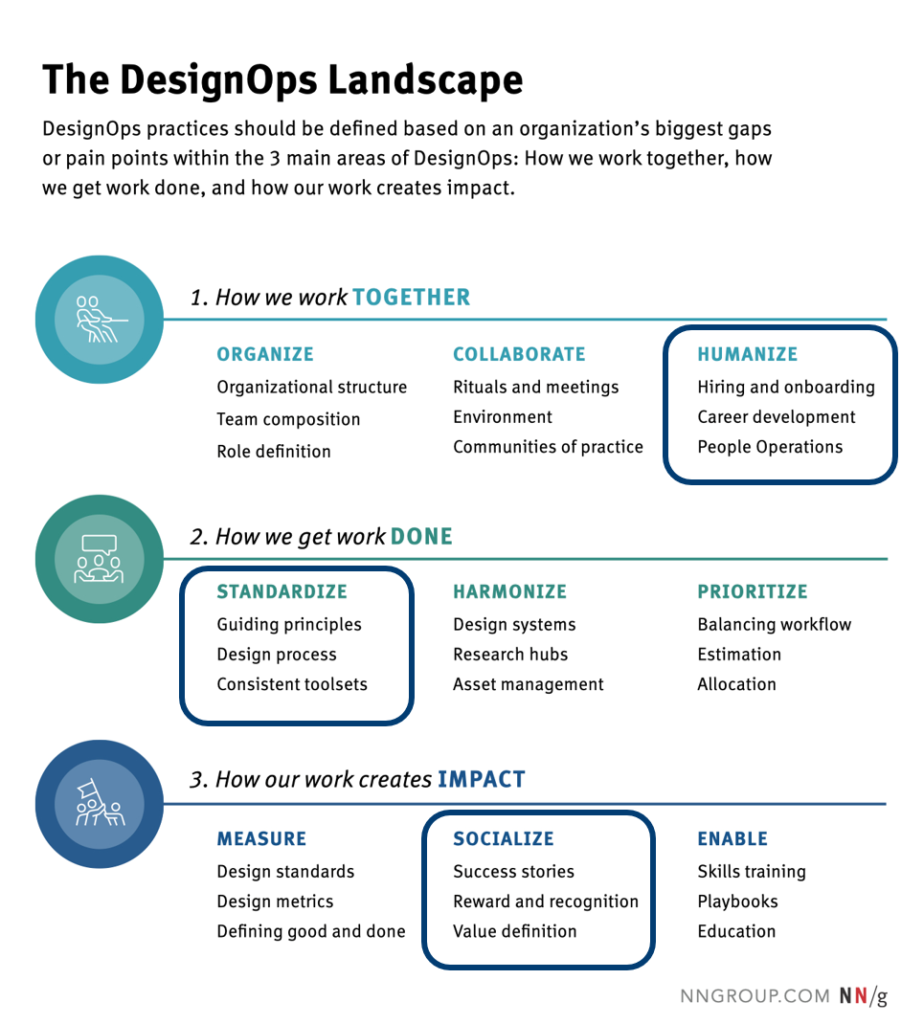
Iterative Design
Over several iterations, I explored how well designers understood what was written in my first versions of a matrix, and whether it was useful to them. I tested these iterations with a small sample of the team before releasing it to the larger team. Evaluation had its own challenges identified in the next section.
These iterations resulted in a final artifact with two main parts:
- General Traits of a UX designer from a birds-eye view
- Detailed UX Skills required for the role
General Traits
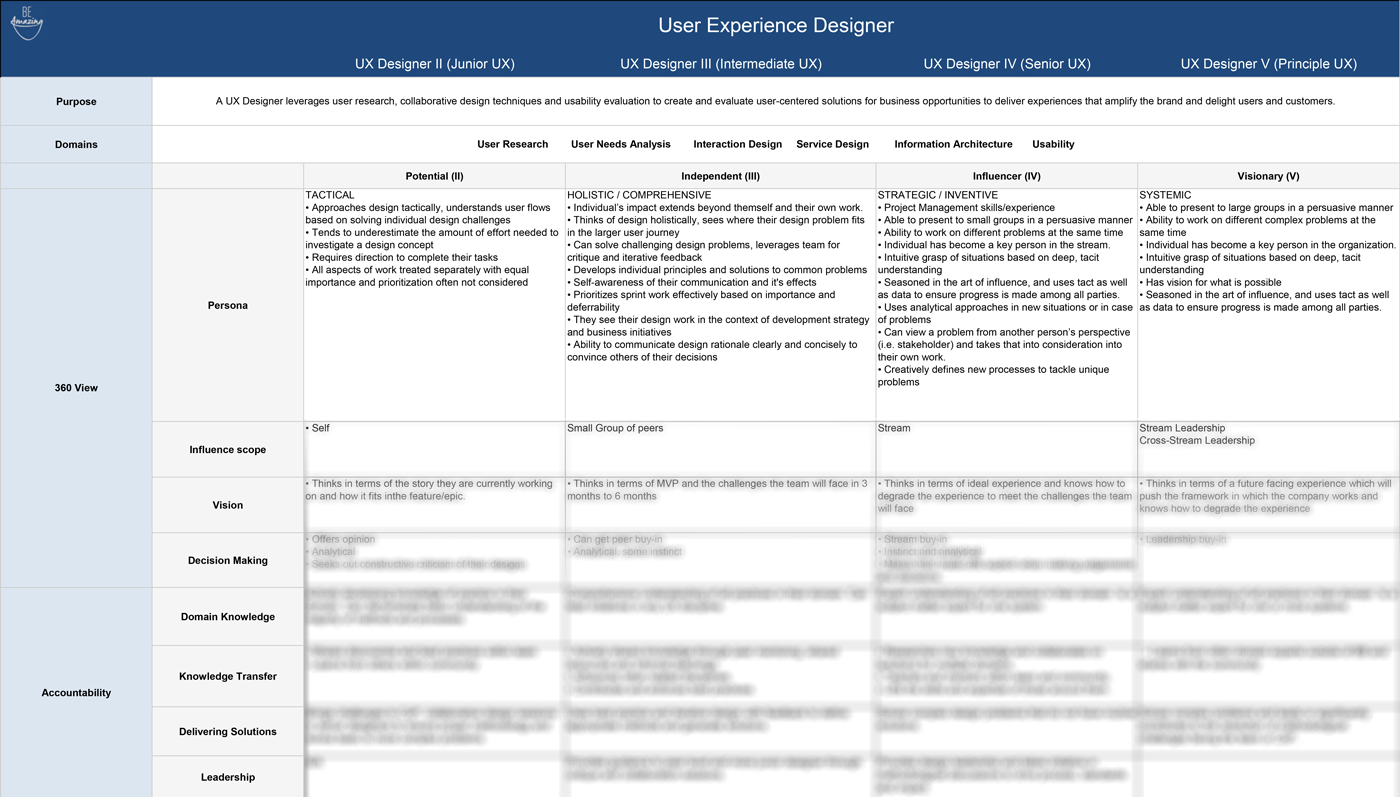
Detailed Skills
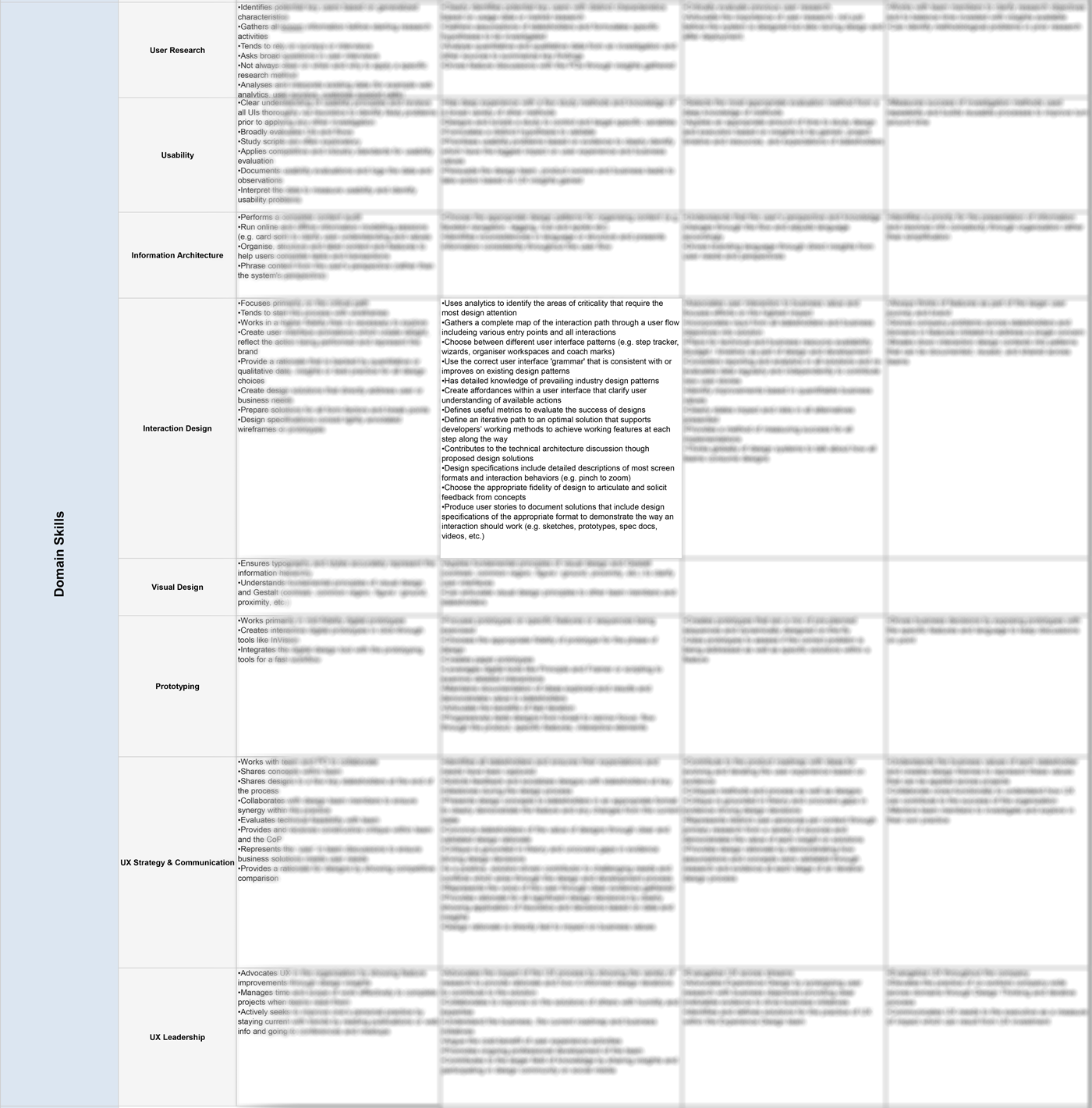
Evaluation
Finding a method of evaluation that allowed consistent measurement and clear direction proved challenging.
Self-Assessment
Junior designers consistently ranked themselves higher than more senior designers.
During self-assessment it was discovered in repeated trials with several survey methods that junior designers didn’t understand the specifics of the descriptions of more advanced methods. They thought they were performing these skills even in the presence of descriptive behaviours.
Initial Self-Assessment
In early trials I gave designers a more standardized scoring sheet separately from the detailed descriptions of each. Disconnecting the descriptions from the scoring sheet proved problematic as designers had to read through a large block of the matrix and make a more general determination across a wide variety of skills.
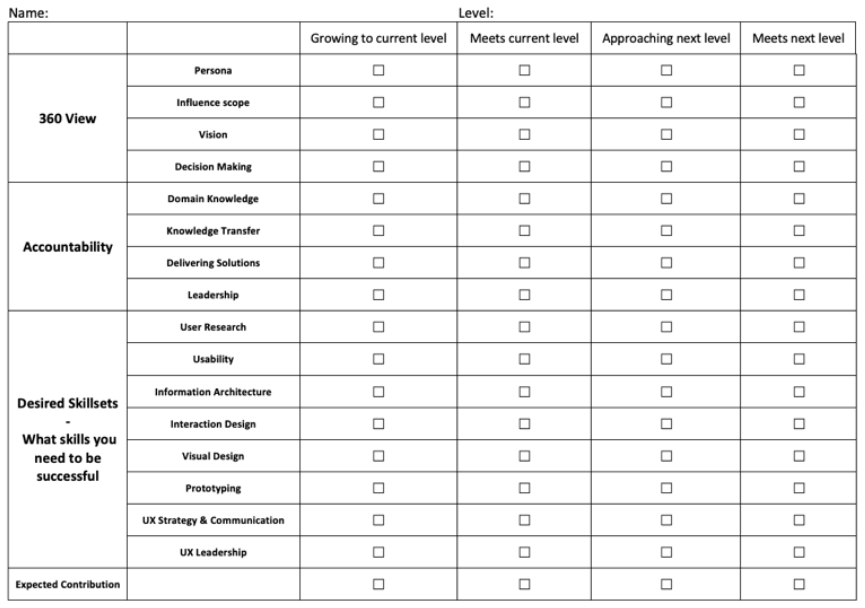
Detailed Self-Assessment
In another early iteration, I included the descriptions within the scoring sheet but again, the volume and detail of the information was overwhelming. While this level of detail was essential for clarity of each skills, it made scoring very difficult.
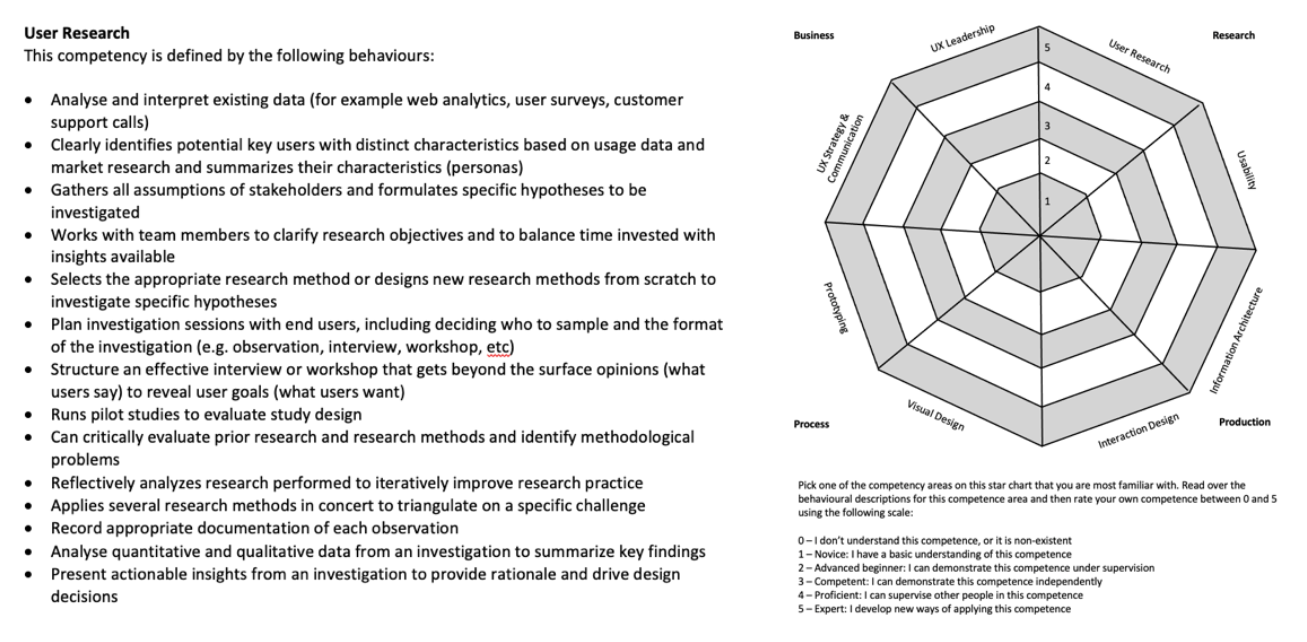
Collaborative Assessment
Building recognition by identifying successes and challenges through specific examples.
The solution I ultimately settled on was a collaborative assessment.
Collaborative Assessment had two key elements:
- One-on-one identification of successess and areas that were opportunities for growth
- Building a culture of identifying examples of “What good looks like”
Once a quarter I would go through the relevant columns in the career framework with each designer and ask them to identify examples they had seen for key skills, both in their own work and in others’ work. We also discussed which skills each designer was targetting for growth and who on the design team they could use as a mentor in those areas. In this way I built a culture of identifying “what good looks like” and a collaborative learning environment where designers leveraged each other for improvement.
COLLABORATIVE-ASSESSMENT
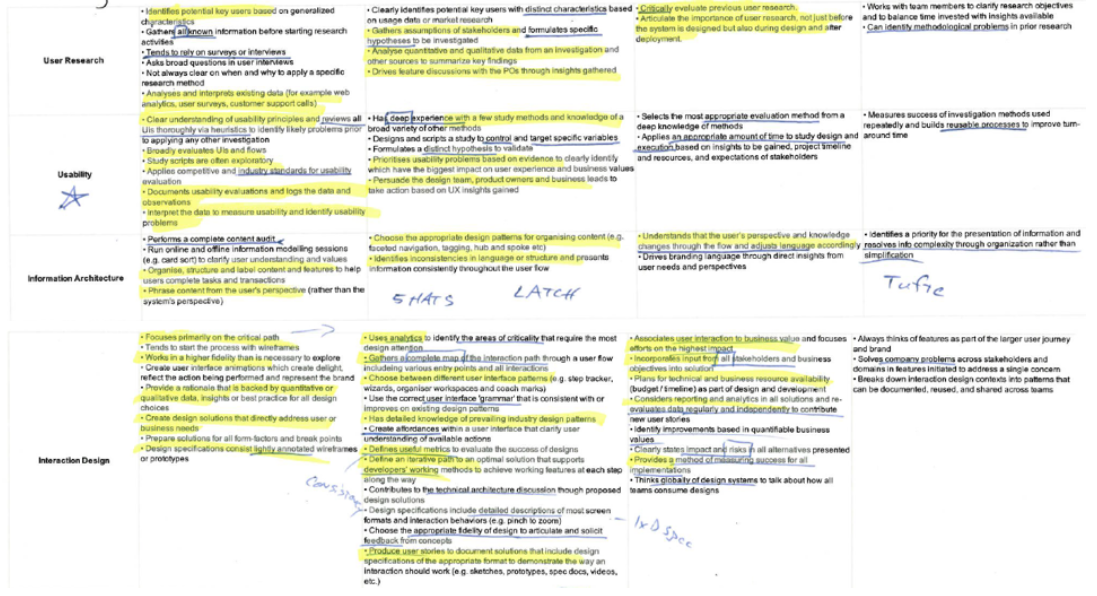
Outcomes
This process met the initial goals with several resounding successes. The most amazing outcome was that designers ran with this on their own and in groups without leadership involvement. Because we had already established targetting each other for examples of what good looked like, they began calling these out on their own publicly and build a library of exemplary work they could use as a guide.
Results
- Culture of Excellence
- Designers documented their wins and examples of the best of what we were doing
- Experts emerged in various subject areas and the team leveraged each other for growth
- Examples of the best of our work aligned our artifacts consistently around the best received presentations
- Excitement about Career Growth
- A clear representation of what the field offered gave designers targets that they could get excited about and a path to grow their own practices
- The design team was accellerating their learning and toolbox of skills and capabilities
- Consistent Skill Measurement
- Each designer knew exactly where they mapped on the career ladder through specific examples
- Performance improvement was well documented each quarter
- Hiring managers and interview committees had a specific guage to measure applicants’ skills
- Map of Team Skills
- The capabilities of the team were documented within a fine-grained skills matrix to show where our strengths and weaknesses lied
- Diverse capabilities and skills could be targetted during recruiting and hiring
The impact of this drive for excellence on our external collaborators showed up as an increased demand for UX involvement in more projects across a wider range of verticals. Leaders in other areas were hearing of our successes and asking for UX beyond eCommerce, in the retail stores, in the warehouse and in the employee enterprise experience teams.
Through the excellence this project brought to UX, I was able to triple the size of the UX team in 3 years.
